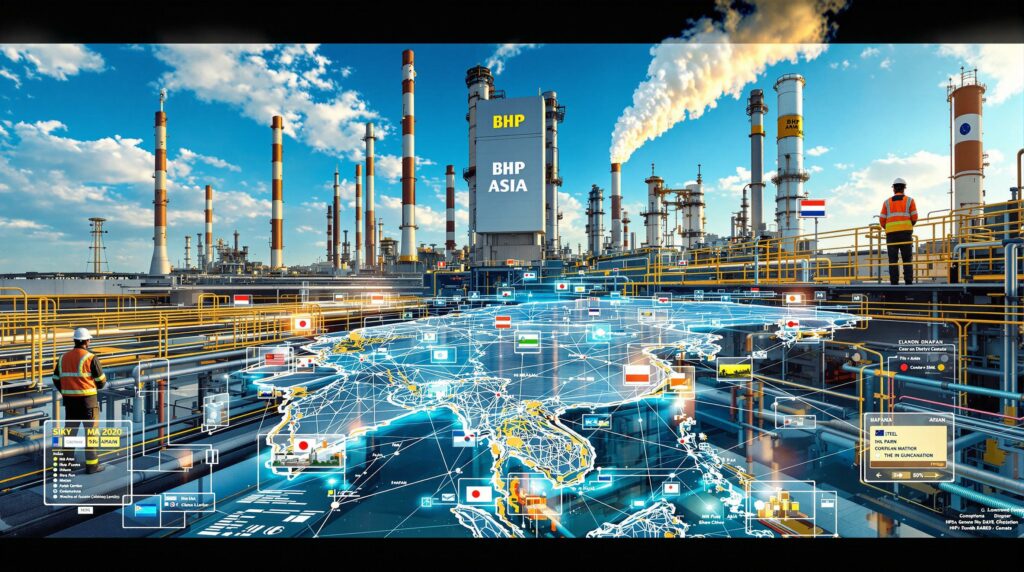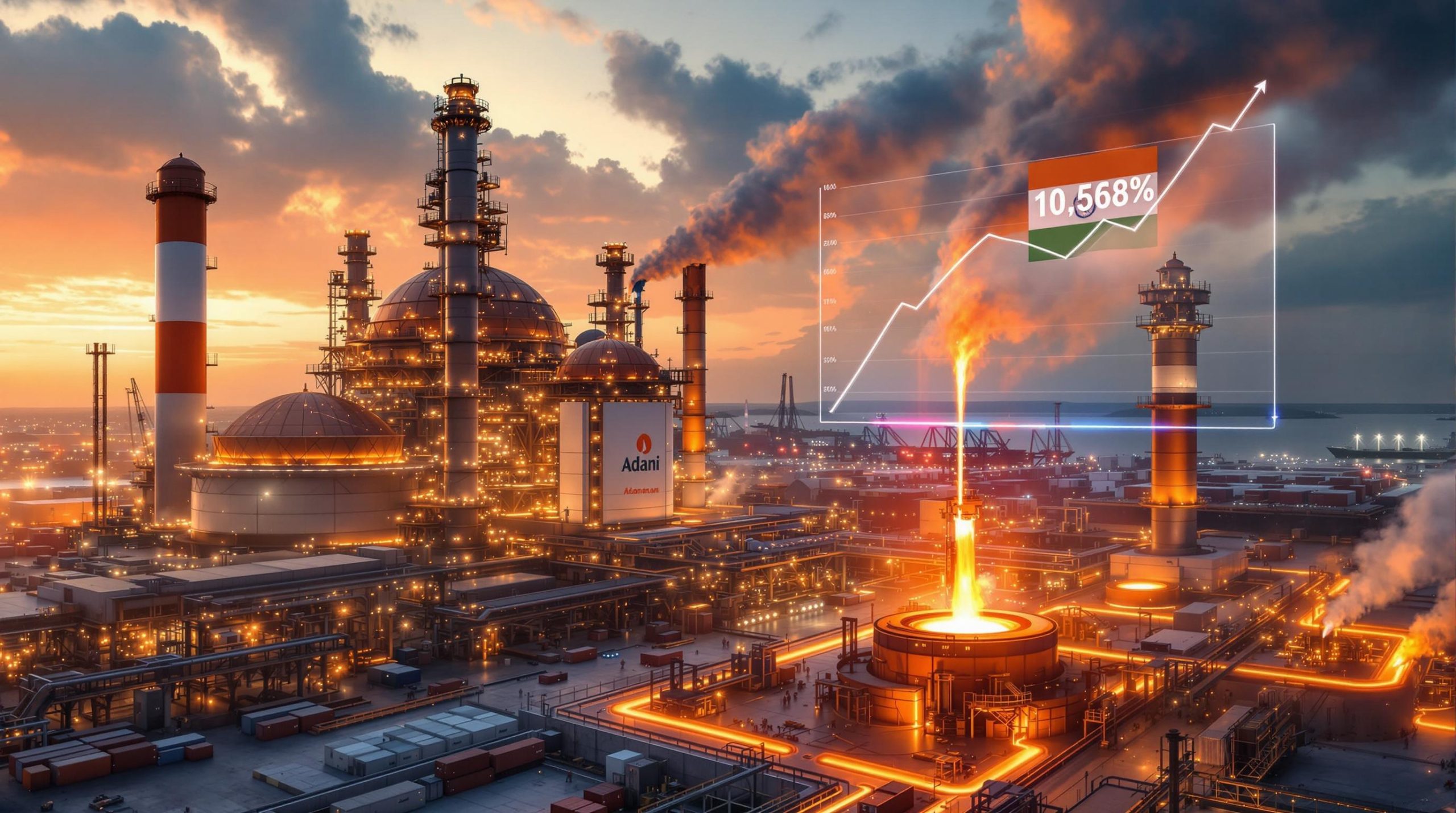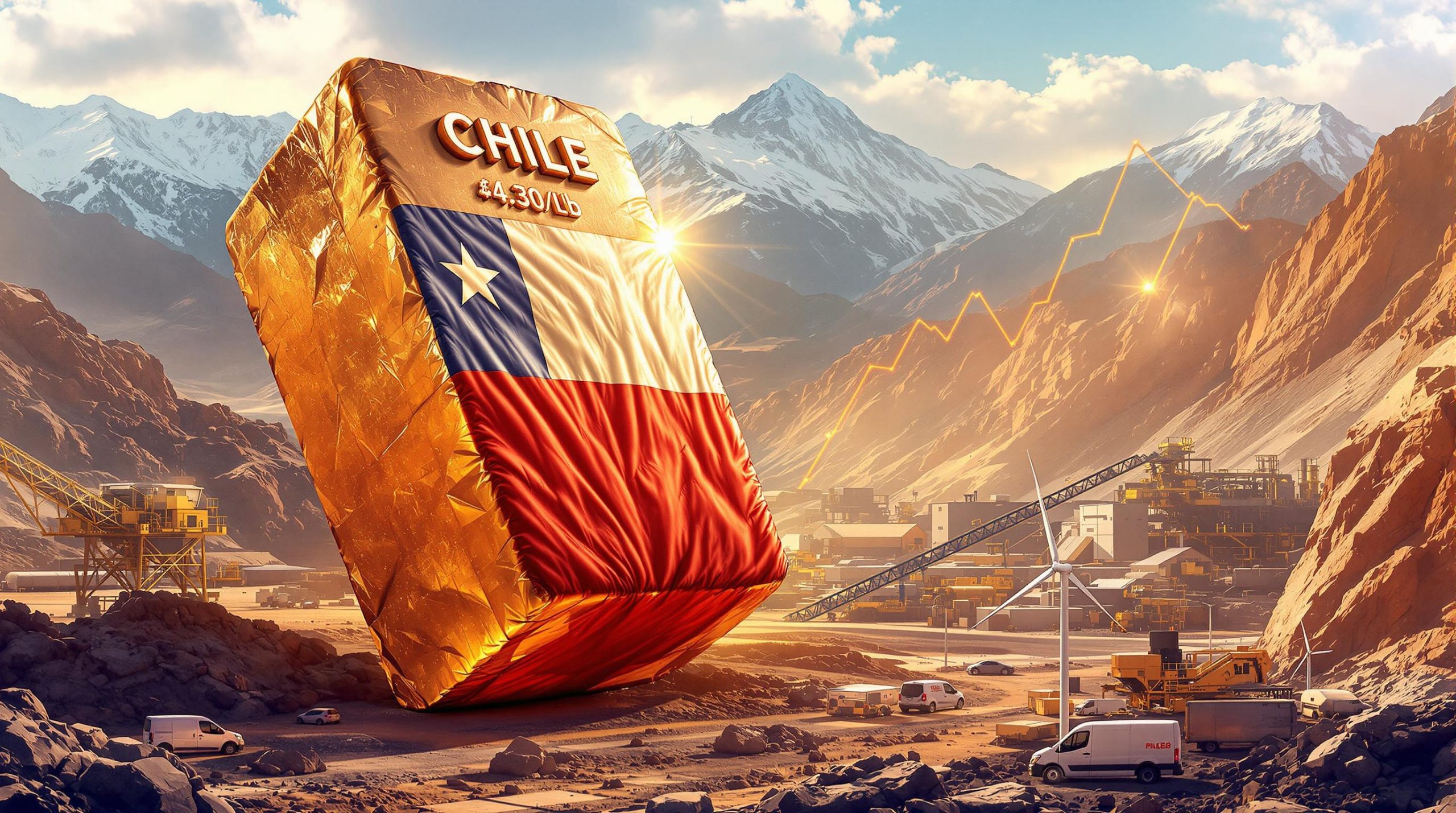BHP Leads Global Steelmakers Group to Study Asian Carbon Capture Hubs
A groundbreaking international consortium led by mining giant BHP has launched an ambitious initiative to evaluate carbon capture solutions for the steel industry across Asia. This collaboration brings together major global players to address one of the most challenging aspects of industrial decarbonization, with potential far-reaching implications for climate goals and the future of steel production.
What is the BHP-Led Carbon Capture Consortium?
The Formation of a Groundbreaking Industry Alliance
The consortium represents a first-of-its-kind collaboration between mining, steel, and energy sectors, uniting six major global companies under BHP's leadership. Participating organizations include ArcelorMittal Nippon Steel India, JSW Steel, Hyundai Steel, Chevron Corporation, and Mitsui & Co, with project management provided by the engineering firm Hatch.
Launched in 2023, the group has initiated a one-year pre-feasibility study to explore carbon capture opportunities specifically tailored to Asian markets. According to the official announcement, findings from this initial phase are expected to be made public, with the broader study expected to conclude by the end of 2026.
"By leveraging shared knowledge and resources with our partners, we are investing in support for innovative solutions, like the potential of CCUS, that we see as an essential part of decarbonizing hard-to-abate sectors such as steelmaking," stated Ben Ellis, BHP's Vice President of Marketing Sustainability.
What makes this consortium particularly noteworthy is its cross-industry nature, bringing together upstream resource providers, steel manufacturers, energy companies, and technical expertise under a unified vision for carbon management.
Strategic Goals of the Consortium
The consortium has outlined several key strategic objectives that will guide its work over the coming years:
- Technology evaluation: Assessing the most promising Carbon Capture, Utilization and Storage (CCUS) technologies specifically for steel manufacturing applications
- Infrastructure development: Exploring how shared carbon capture infrastructure can distribute costs, risks, and technical challenges across multiple industry partners
- Scale achievement: Aggregating sufficient CO₂ volumes across multiple facilities to make storage or utilization economically viable
- Risk distribution: Creating models for sharing financial, technical, and operational risks among consortium participants
- Utilization pathways: Identifying potential applications for captured carbon dioxide, including industrial uses and permanent storage options
Unlike many previous carbon capture initiatives, this consortium places particular emphasis on the economic feasibility of deployment in Asian markets, where regulatory frameworks and cost structures differ significantly from Western regions where most CCUS development has occurred to date.
Why is Carbon Capture Critical for Steelmaking?
The Challenge of Decarbonizing "Hard-to-Abate" Sectors
The steel industry faces unique decarbonization challenges that make carbon capture particularly relevant. Steel manufacturing is classified as a "hard-to-abate" sector due to several fundamental factors:
- Process emissions: Unlike many industries where emissions come primarily from energy use, steelmaking produces CO₂ as an inherent byproduct of the chemical reduction of iron ore
- High temperature requirements: Steel production requires temperatures exceeding 1,500°C, making electrification extremely difficult
- Coal dependency: Traditional blast furnace technology relies on metallurgical coal not just for heat but as a chemical reducing agent
- Global scale: The industry produces approximately 1.9 billion tons of steel annually, accounting for 7-9% of global carbon emissions
- Infrastructure longevity: Steel plants represent multi-decade investments, with blast furnaces typically operating for 20+ years before requiring replacement
Industry context: "Steel production is one of the most carbon-intensive industrial processes, emitting on average 1.85 tons of CO₂ for every ton of steel produced through the traditional blast furnace route," explains the International Energy Agency in its Iron and Steel Technology Roadmap.
These factors combine to create a particularly challenging decarbonization landscape. While green hydrogen and electric arc furnace technologies offer long-term pathways to emissions reduction, carbon sequestration innovations provide a potentially faster route to meaningful emissions reductions using existing production infrastructure.
Current State of Carbon Capture Technologies
While carbon capture is often portrayed as an emerging technology, the fundamental processes have been used in industrial applications for decades. However, scaling these technologies to address steel industry emissions presents unique challenges:
- Technology maturity: Basic carbon capture technologies are considered "relatively mature" but face implementation barriers
- Cost barriers: The economic equation remains challenging, particularly in Asian markets with varied carbon pricing mechanisms
- Efficiency considerations: Energy penalties for carbon capture can increase overall energy consumption by 15-30%
- Infrastructure gaps: Most steel-producing regions lack the necessary CO₂ transportation and storage infrastructure
- Regulatory frameworks: Many Asian countries are still developing the necessary regulations for CO₂ transportation, storage, and liability
The consortium aims to address these challenges by exploring how shared infrastructure models could improve the economics of deployment across multiple facilities and countries. By aggregating CO₂ volumes and distributing costs, the initiative hopes to overcome the scale barriers that have limited carbon capture deployment to date.
How Could Asian Carbon Capture Hubs Transform Heavy Industry?
Potential Regional Impact of Successful Implementation
Asia dominates global steel production, manufacturing over 70% of the world's steel with China alone accounting for more than half of global output. This concentration creates both challenges and opportunities for carbon capture implementation.
The strategic inclusion of major producers from India, Japan, and South Korea in the consortium reflects the regional diversity of Asian steel production. Each country faces different regulatory environments, energy systems, and decarbonization pressures, requiring tailored approaches to carbon capture implementation.
Successful development of carbon capture hubs could potentially:
- Create regional decarbonization models that can be replicated across similar industrial clusters
- Establish technical standards for carbon capture, transportation, and storage/utilization
- Develop skilled workforce capacity in carbon management technologies
- Attract additional investment in complementary low-carbon technologies
- Maintain competitiveness of Asian steel in increasingly carbon-conscious global markets
The hub model is particularly relevant in Asia, where industrial concentration in coastal manufacturing zones could facilitate shared infrastructure development. Ports that currently handle coal imports could potentially be repurposed for CO₂ export, creating synergies with existing infrastructure.
Models for Shared Infrastructure Development
A central focus of the consortium's work involves evaluating various models for shared carbon management infrastructure. Several potential approaches are likely under consideration:
- Hub-and-spoke networks: Central collection points gathering CO₂ from multiple industrial facilities via pipeline networks
- Port-based export hubs: Coastal facilities where captured CO₂ is liquefied and shipped to offshore storage locations
- Industrial utilization clusters: Co-located facilities where captured carbon is converted into commercial products
- Cross-border transportation systems: International pipeline networks connecting capture sources with storage locations
- Hybrid public-private models: Government-supported backbone infrastructure with private industry connections
Infrastructure insight: "The economics of carbon capture improve dramatically with scale. A shared pipeline carrying CO₂ from multiple sources can reduce transportation costs by 30-50% compared to individual, facility-specific solutions," notes the Global CCS Institute.
These infrastructure models represent more than technical solutions—they require new business models, risk-sharing frameworks, and regulatory approaches that cross traditional industry boundaries. The consortium's evaluation of these options could establish blueprints for future deployment across other regions and sectors.
What Technical Approaches Are Being Considered?
Carbon Capture Methodologies Under Evaluation
While the consortium has not publicly detailed the specific technologies under consideration, several carbon capture approaches have potential application in steelmaking:
- Post-combustion capture: Removing CO₂ from flue gases after combustion using chemical absorption, typically with amine solvents
- Pre-combustion capture: Converting fuel into hydrogen and CO₂ before combustion, allowing for separation
- Oxyfuel combustion: Burning fuel with pure oxygen instead of air, producing a concentrated CO₂ stream
- Direct separation: Capturing CO₂ directly from process gases in certain steelmaking stages
- Innovative sorbents: Evaluating solid sorbents and membranes that may offer efficiency improvements over liquid solvents
Each approach offers different advantages and challenges in terms of retrofit potential, energy requirements, capture efficiency, and costs. The optimal solution likely varies based on facility age, configuration, and local conditions.
Technical considerations extend beyond the capture process itself to include:
- Compression and dehydration requirements for transportation
- Purity specifications for different utilization or storage pathways
- Monitoring systems for emissions verification and carbon accounting
- Integration with existing production processes to minimize disruption
- Scalability pathways from initial deployment to full-scale implementation
Carbon Utilization and Storage Options
Once captured, CO₂ must either be permanently stored or converted into useful products. The consortium is reportedly evaluating various pathways, which could include:
-
Geological storage: Injecting CO₂ into deep underground formations, such as:
- Depleted oil and gas fields
- Deep saline aquifers
- Basalt formations with mineralization potential
-
Utilization pathways: Converting CO₂ into valuable products, including:
- Building materials (concrete, aggregates, carbonate minerals)
- Chemical feedstocks for industrial processes
- Synthetic fuels when combined with hydrogen
- Enhanced oil recovery applications
-
Integration with hydrogen production: Using captured carbon in combination with green hydrogen initiatives for steel production
The Asia-Pacific region offers varied geological storage potential, with significant capacity identified in parts of China, Japan, and Southeast Asia. However, detailed characterization of storage sites remains a critical need in many potential hub locations.
What Are the Economic and Regulatory Challenges?
Financial Barriers to Implementation
The economics of carbon capture present perhaps the most significant barrier to widespread adoption. Cost considerations include:
- Capital expenditure (CAPEX): Capture equipment typically adds 25-40% to the capital cost of a steel plant
- Operational expenditure (OPEX): Energy penalties increase operating costs by approximately 15-30%
- Infrastructure investment: Transportation networks require significant upfront investment with long payback periods
- Monitoring costs: Long-term verification and maintenance add ongoing expenses
- Carbon pricing gap: In many Asian markets, carbon prices (if they exist) remain below the cost of capture
Economic context: "For carbon capture to become economically viable in steelmaking, either the cost of technology must decrease significantly, or the effective price of carbon must increase to $50-100 per ton in most markets," according to the International Energy Agency.
The consortium's focus on shared infrastructure and risk distribution directly addresses these economic challenges. By aggregating CO₂ volumes and spreading infrastructure costs across multiple facilities, the initiative aims to improve the business case for carbon capture deployment.
Regulatory Framework Development Needs
Regulatory considerations vary significantly across Asian countries, creating a complex landscape for cross-border carbon management. Key regulatory needs include:
- CO₂ classification standards: Determining whether captured CO₂ is classified as a waste, commodity, or pollutant
- Pipeline regulations: Establishing safety and monitoring requirements for CO₂ transportation
- Storage liability frameworks: Clarifying long-term responsibility for stored CO₂
- Cross-border transportation protocols: Developing standards for international CO₂ movement
- Carbon accounting methodologies: Creating verified approaches to quantify captured and stored emissions
The pre-feasibility study will likely include regulatory mapping across potential hub locations, identifying both barriers and enablers in the current policy environment. This analysis could inform policy recommendations to facilitate carbon capture deployment across the region.
How Does This Initiative Compare to Global Decarbonization Efforts?
International Context for Steel Industry Decarbonization
The BHP-led consortium represents one approach among several competing decarbonization pathways being pursued globally. Other notable initiatives include:
- Europe's H2 Green Steel: Building greenfield hydrogen-based steel plants without blast furnaces
- ArcelorMittal's Smart Carbon: Integrating multiple technologies including carbon capture, hydrogen, and circular carbon
- POSCO's Hydrogen Roadmap: South Korean steelmaker's plan to transition to hydrogen-based production by 2050
- U.S. Department of Energy's Industrial Decarbonization Roadmap: Federal framework including CCUS pathways
The Asian consortium distinguishes itself through its regional focus and emphasis on shared infrastructure models. While European initiatives often prioritize hydrogen-based production, the BHP-led approach recognizes the continued role of existing assets in regions with younger steel plants and different economic considerations.
Alternative Decarbonization Pathways
Carbon capture represents one of several potential pathways to lower-emission steel production. Alternatives include:
-
Hydrogen-based direct reduction: Replacing coal with hydrogen as the reducing agent
- Requires access to low-cost green hydrogen
- Offers deeper decarbonization potential (up to 95%)
- Higher capital costs for new facilities
-
Electric arc furnace expansion: Increasing scrap-based production
- Limited by scrap availability in growing markets
- Requires low-carbon electricity to maximize benefits
- Generally lower capital intensity than integrated mills
-
Biomass substitution: Replacing fossil carbon with biogenic carbon
- Constrained by sustainable biomass availability
- Offers partial rather than complete decarbonization
- Potentially lower implementation costs
-
Efficiency improvements: Optimizing existing processes
- Limited potential (typically 10-20% emissions reduction)
- Lower capital requirements
- Often economically attractive regardless of climate goals
The consortium's focus on carbon capture doesn't preclude these alternative approaches. Indeed, many steelmakers are pursuing portfolio strategies that include multiple pathways, recognizing that different solutions may be optimal for different facilities and timeframes.
What Are the Expected Outcomes of the Study?
Anticipated Deliverables and Timeline
The consortium has indicated that the pre-feasibility study will run for approximately one year, with broader findings expected by the end of 2026. Based on similar industry initiatives, likely deliverables include:
- Technical feasibility assessment: Evaluation of capture technologies most suitable for Asian steel plants
- Hub configuration models: Detailed designs for potential shared infrastructure arrangements
- Economic analysis: Cost projections and business models for various implementation scenarios
- Policy roadmap: Identification of regulatory enablers and barriers across target markets
- Risk assessment framework: Methodologies for allocating and managing project risks
- Implementation pathways: Phased approaches for moving from concept to deployment
The commitment to making findings public suggests a collaborative approach that could benefit the broader industry beyond consortium members. This knowledge-sharing component is particularly valuable given the pre-competitive nature of many mining decarbonisation trends.
Potential Next Steps After Study Completion
While the consortium has not specified actions beyond the study phase, successful completion could lead to several potential developments:
- Demonstration project selection: Identifying specific locations for initial deployment
- Investment consortium formation: Structuring financial vehicles for infrastructure development
- Policy engagement: Working with governments to address regulatory barriers
- Technology partner selection: Engaging equipment suppliers and engineering firms
- Expanded industry participation: Bringing additional steel producers into implementation phases
The three-year timeline suggests a deliberate, thorough approach to evaluation before significant capital deployment. This measured pace reflects both the technical complexity of carbon capture systems and the need to develop supportive policy frameworks in parallel with technology assessment.
FAQ: BHP-Led Carbon Capture Initiative
What makes the steel industry particularly challenging to decarbonize?
Steel manufacturing presents unique decarbonization challenges due to its fundamental chemistry and scale. The traditional blast furnace process uses coal not just as a heat source but as a chemical reducing agent to convert iron ore into iron. This produces CO₂ as an inherent byproduct of the chemical reaction. Additionally, the extremely high temperatures required (over 1,500°C) make electrification difficult, while the industry's massive global scale—producing nearly 2 billion tons annually—means solutions must be both technically and economically viable at tremendous scale.
Why is BHP leading this initiative rather than a steelmaker?
As the world's largest mining company and a major supplier of both iron ore and metallurgical coal to steelmakers, BHP has strategic interest in the long-term sustainability of steel production. The company faces significant "Scope 3" emissions exposure through its customers' use of its products. By taking a leadership role in decarbonization initiatives, BHP positions itself to influence technical pathways that align with its resource portfolio while demonstrating climate action to increasingly ESG-conscious investors. The company's global scale, financial resources, and existing relationships with major steelmakers make it well-positioned to coordinate such a complex, multi-stakeholder initiative.
How does carbon capture differ from other decarbonization approaches?
Unlike alternative approaches that fundamentally change the production process (such as hydrogen-based steelmaking), carbon capture allows continued use of existing infrastructure while removing emissions before they enter the atmosphere. This represents a potentially faster implementation path for facilities with significant remaining operational lifetimes. Carbon capture can also address process emissions that efficiency improvements cannot eliminate. However, it typically achieves partial rather than complete decarbonization (60-90% capture rates) and requires significant energy input, which must come from low-carbon sources to maximize energy transition impact.
What economic benefits might carbon capture hubs provide?
Shared carbon capture infrastructure can deliver substantial economic advantages through economies of
Ready to Stay Ahead of Major ASX Mineral Discoveries?
Gain immediate, real-time alerts on significant mineral discoveries announced on the ASX with Discovery Alert's proprietary Discovery IQ model, turning complex geological data into actionable investment insights. Visit the Discovery Alert discoveries page to understand how major mineral discoveries have historically generated substantial returns for early investors.




